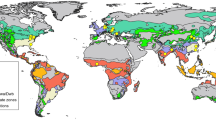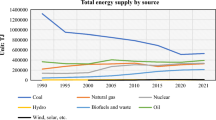Abstract
Meta-analysis and other statistical methods were used to evaluate how changes in soil organic carbon (SOC) content in post-mining soils are related to different factors; the data were obtained from 17 studies covering 93 temperate post-mining sites in the Northern Hemisphere that had been revegetated by forest or grassland either by reclamation or natural succession. Because many studies have failed to report any measures of variance, only part of the data were used for meta-analysis. According to the meta-analysis, the rate of SOC accumulation was unrelated to vegetation type. In a separate analysis that included all available data and in which rates of SOC accumulation at each site were used as individual entries, the rate of SOC accumulation differed depending on the age of the site and vegetation type. Under deciduous forests, the rate reached a maximum after 5–10 years and then decreased. Under coniferous forests, the initial SOC values were lower than under deciduous forests, but slowly increased with age and reached a maximum after 30–40 years. No significant temporal trend was found in grasslands, probably because the data set included only relatively young grassland sites. Based on data from sites younger than 30 years, sites with grasslands and deciduous forests accumulated SOC faster than sites with coniferous forests. The rate of accumulation was negatively correlated with temperature under coniferous forests, but positively correlated with temperature in grasslands. This suggests that carbon sequestration is favored by cold climates in coniferous forests, but by warm climates in grasslands. Deciduous forests were intermediate. Compared to conifers, deciduous trees may support SOC sequestration deeper in the soil profile, which may enhance SOC stability. A large proportion of post-mining sites reach the pre-mining SOC stock within 20 years or less after reclamation.



Similar content being viewed by others
References
Abdul- Kareem AW, McRae SG (1984) The effects on topsoil of long-term storage in stockpiles. Plant Soil 76(1–3):357–363
Akala VA, Lal R (2001) Soil organic carbon pools and sequestration rates in reclaimed minesoils in Ohio. J Environ Qual 30(6):2098–2104
Amichev BY (2007) Biogeochemistry of carbon on disturbed forest landscapes. Ph.D. Dissertation, Virginia Polytechnic Institute and State University, Blacksburg, VA
Amichev BY, Burger JA, Rodrigue JA (2008) Carbon sequestration by forests and soils on mined land in the Midwestern and Appalachian coalfields of the US. For Ecol Manag 256(11):1949–1959. doi:10.1016/j.foreco.2008.07.020
Anderson JD, Ingram LJ, Stahl PD (2008) Influence of reclamation management practices on microbial biomass carbon and soil organic carbon accumulation in semiarid mined lands of Wyoming. Appl Soil Ecol 40(2):387–397. doi:10.1016/j.apsoil.2008.06.008
Bradshaw AD (1983) The reconstruction of ecosystems. Presidential address to the British Ecological Society, December 1982. J Appl Ecol 20(1):1–17
Bradshaw A (2000) The use of natural processes in reclamation—advantages and difficulties. Landsc Urban Plann 51(2–4):89–100
Brown JH, Gibson AC (1983) Biogeography. C. V. Mosby, Saint Louis
Carter MR (2002) Soil quality for sustainable land management: organic matter and aggregation interactions that maintain soil functions. Agron J 94(1):38–47
Chatterjee A, Lal R, Shrestha RK, Ussiri DAN (2009) Soil carbon pools of reclaimed minesoils under grass and forest landuses. Land Degrad Dev 20(3):300–307. doi:10.1002/ldr.916
Curtis PS, Wang XZ (1998) A meta-analysis of elevated CO2 effects on woody plant mass, form, and physiology. Oecologia 113(3):299–313
Fettweis U, Bens O, Huttl RF (2005) Accumulation and properties of soil organic carbon at reclaimed sites in the Lusatian lignite mining district afforested with Pinus sp. Geoderma 129(1–2):81–91. doi:10.1016/j.geoderma.2004.12.034
Filcheva E, Noustorova M, Gentcheva-Kostadinova S, Haigh MJ (2000) Organic accumulation and microbial action in surface coal-mine spoils, Pernik, Bulgaria. Ecol Eng 15(1–2):1–15
Frouz J, Kalčík J (2006) Accumulation of soil organic carbon in relation to other soil characteristic during spontaneous succession in non reclaimed colliery spoil heaps after brown coal mining near Sokolov (the Czech Republic). Ekológia 25(4):388–397
Frouz J, Pizl V, Cienciala E, Kalcik J (2009) Carbon storage in post-mining forest soil, the role of tree biomass and soil bioturbation. Biogeochemistry 94(2):111–121. doi:10.1007/s10533-009-9313-0
Ganjegunte GK, Wick AF, Stahl PD, Vance GF (2009) Accumulation and composition of total organic carbon in reclaimed coal mine lands. Land Degrad Dev 20(2):156–175. doi:10.1002/ldr.889
Guo LB, Gifford RM (2002) Soil carbon stocks and land use change: a meta analysis. Glob Change Biol 8(4):345–360
Hedges LV, Olkin I (1985) Statistical methods for meta-analysis. Academic Press, Orlando
Ingram LJ, Schuman GE, Stahl PD, Spackman LK (2005) Microbial respiration and organic carbon indicate nutrient cycling recovery in reclaimed soils. Soil Sci Soc Am J 69(6):1737–1745. doi:10.2136/sssaj2004.0371
Karu H, Szava-Kovats R, Pensa M, Kull O (2009) Carbon sequestration in a chronosequence of Scots pine stands in a reclaimed opencast oil shale mine. Can J For Res 39(8):1507–1517. doi:10.1139/x09-069
Keskin T, Makineci E (2009) Some soil properties on coal mine spoils reclaimed with black locust (Robinia pceudoacacia L.) and umbrella pine (Pinus pinea L.) in Agacli-Istanbul. Environ Monit Assess 159(1–4):407–414. doi:10.1007/s10661-008-0638-2
Laganiere J, Angers DA, Pare D (2010) Carbon accumulation in agricultural soils after afforestation: a meta-analysis. Glob Change Biol 16(1):439–453. doi:10.1111/j.1365-2486.2009.01930.x
Lal R (2005) Forest soils and carbon sequestration. For Ecol Manag 220(1–3):242–258. doi:10.1016/j.foreco.2005.08.015
Lal R, Kimble JM (2001) Importance of soil bulk density and methods of its measurement. In: Lal R, Kimble JM, Follett RF, Stewart BA (eds) Assessment methods for soil carbon. advances in soil science. CRC Press, Boca Raton, pp 31–44
Liao CZ, Peng RH, Luo YQ, Zhou XH, Wu XW, Fang CM, Chen JK, Li B (2008) Altered ecosystem carbon and nitrogen cycles by plant invasion: a meta-analysis. New Phytol 177(3):706–714. doi:10.1111/j.1469-8137.2007.02290.x
Lorenz K, Lal R (2007) Stabilization of organic carbon in chemically separated pools in reclaimed coal mine soils in Ohio. Geoderma 141(3–4):294–301. doi:10.1016/j.geoderma.2007.06.008
Morgenroth G, Kretschmer W, Scharf A, Uhl T, Fettweis U, Bens O, Huttl RF (2004) C-14 measurement of soil in post-mining landscapes. Nucl Instrum Methods Phys Res B 223:568–572. doi:10.1016/j.nimb.2004.04.105
Nelson DW, Sommers LE (1996) Total carbon, organic carbon, and organic matter. In: Sparks DL et al (eds) Methods of soil analysis. Part 3. chemical method, vol 5. Soil Science Society of America, Madison
Nii-Annang S, Grunewald H, Freese D, Huttl RF, Dilly O (2009) Microbial activity, organic C accumulation and C-13 abundance in soils under alley cropping systems after 9 years of recultivation of Quaternary deposits. Biol Fertil Soils 45(5):531–538. doi:10.1007/s00374-009-0360-4
Paul KI, Polglase PJ, Nyakuengama JG, Khanna PK (2002) Change in soil carbon following afforestation. For Ecol Manag 168(1–3):241–257
Poeplau C, Don A, Vesterdal L, Leifeld J, Van Wesemael BAS, Schumacher J, Gensior A (2011) Temporal dynamics of soil organic carbon after land-use change in the temperate zone—carbon response functions as a model approach. Glob Change Biol. doi:10.1111/j.1365-2486.2011.02408.x
Post WM, Kwon KC (2000) Soil carbon sequestration and land-use change: processes and potential. Glob Change Biol 6(3):317–327
Reintam L (2004) Rehabilited quarry detritus as parent material for current pedogenesis. Oil Shale 21(3):183–193
Reintam L, Kaar E, Rooma I (2002) Development of soil organic matter under pine on quarry detritus of open-cast oil-shale mining. For Ecol Manag 171(1–2):191–198
Ricka A, Kuchovsky T, Sracek O, Zeman J (2010) Determination of potential mine water discharge zones in crystalline rocks at Rozna, Czech Republic. Environ Earth Sci 60(6):1201–1213. doi:10.1007/s12665-009-0261-8
Rumpel C, Balesdent J, Grootes P, Weber E, Kogel-Knabner I (2003) Quantification of lignite and vegetation-derived soil carbon using C-14 activity measurements in a forested chronosequence. Geoderma 112(1–2):155–166
Schwenke GD, Ayre L, Mulligan DR, Bell LC (2000) Soil stripping and replacement for the rehabilitation of bauxite-mined land at Weipa II Soil organic matter dynamics in mine soil chronosequences. Aust J Soil Res 38(2):371–393
Sever H, Makineci E (2009) Soil organic carbon and nitrogen accumulation on coal mine spoils reclaimed with maritime pine (Pinus pinaster Aiton) in Agacli-Istanbul. Environ Monit Assess 155(1–4):273–280. doi:10.1007/s10661-008-0434-z
Shrestha RK, Lal R (2010) Carbon and nitrogen pools in reclaimed land under forest and pasture ecosystems in Ohio, USA. Geoderma 157(3–4):196–205. doi:10.1016/j.geoderma.2010.04.013
Shrestha RK, Lal R (2011) Changes in physical and chemical properties of soil after surface mining and reclamation. Geoderma 161(3–4):168–176. doi:10.1016/j.geoderma.2010.12.015
Shrestha RK, Lal R, Jacinthe PA (2009) Enhancing carbon and nitrogen sequestration in reclaimed soils through organic amendments and chiseling. Soil Sci Soc Am J 73(3):1004–1011. doi:10.2136/sssaj2008.0216
Sourkova M, Frouz J, Santruckova H (2005) Accumulation of carbon, nitrogen and phosphorus during soil formation on alder spoil heaps after brown-coal mining, near Sokolov (Czech Republic). Geoderma 124(1–2):203–214. doi:10.1016/j.geoderma.2004.05.001
Stahl PD, Anderson DJ, Ingram LJ, Schuman GE, Mummey DL Accumulation of organic carbon in reclaimed coal mine soils of Wyoming. In: 2003 National Meeting of the American Society of mining and reclamation and the 9th billings land reclamation symposium, Lexington, KY, 2003. American Society of Mining and Reclamation, pp 1203–1215
Vogel WG (1981) A guide for revegetating coal minespoils in eastern United States. USDA Forest Service Northeastern Forest Experiment Station, Broomall
Acknowledgments
Our special thanks are due to Helen Karu and Doc. Dr. Ender Makineci for providing unpublished data related to their papers. Many thanks are due to Dr. Raj. K. Shrestha, Dr. Graeme Schwenke, Dr. Christopher Barton, and Dr Lachlan Ingram for sharing their papers and useful ideas. This study was supported by a grant from the Ministry of Education of the Czech Republic 2B80023 and by the Research Plan of BC AS CR, v.v.i.-ISB AV0Z60660521 and MSM0021620855. The authors thank Bruce Jaffee for language correction.
Author information
Authors and Affiliations
Corresponding author
Rights and permissions
About this article
Cite this article
Vindušková, O., Frouz, J. Soil carbon accumulation after open-cast coal and oil shale mining in Northern Hemisphere: a quantitative review. Environ Earth Sci 69, 1685–1698 (2013). https://doi.org/10.1007/s12665-012-2004-5
Received:
Accepted:
Published:
Issue Date:
DOI: https://doi.org/10.1007/s12665-012-2004-5




